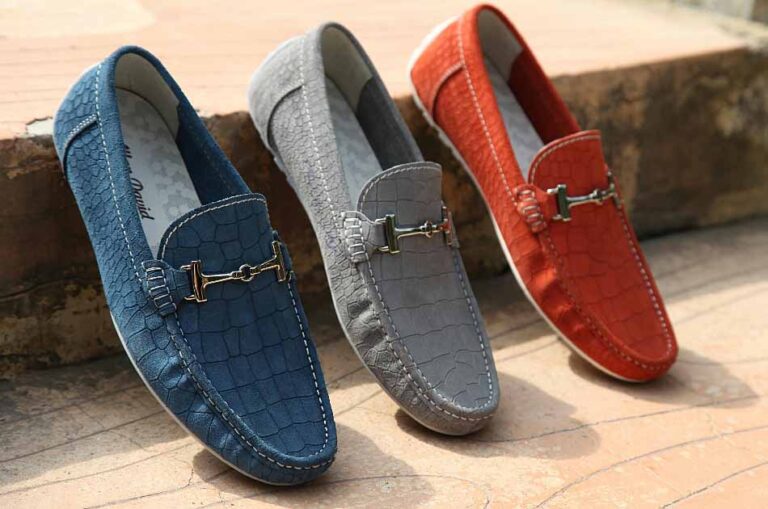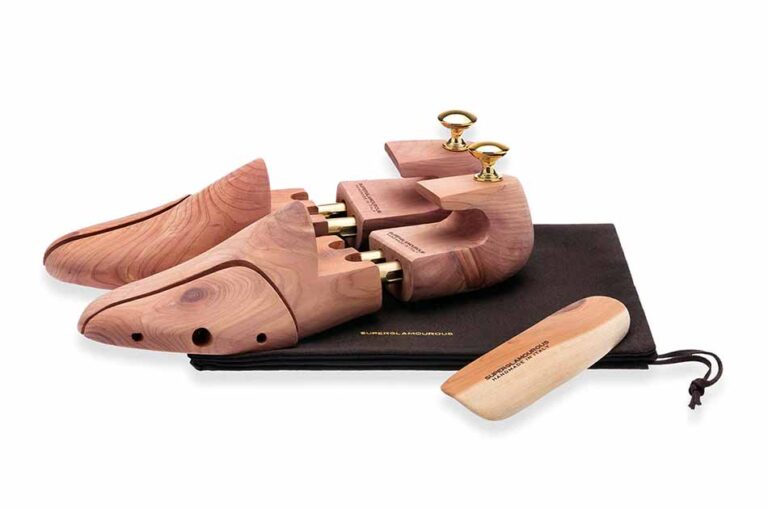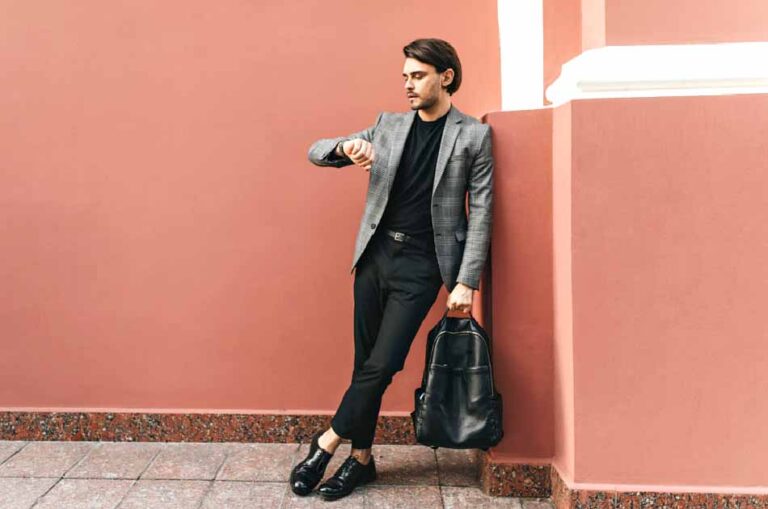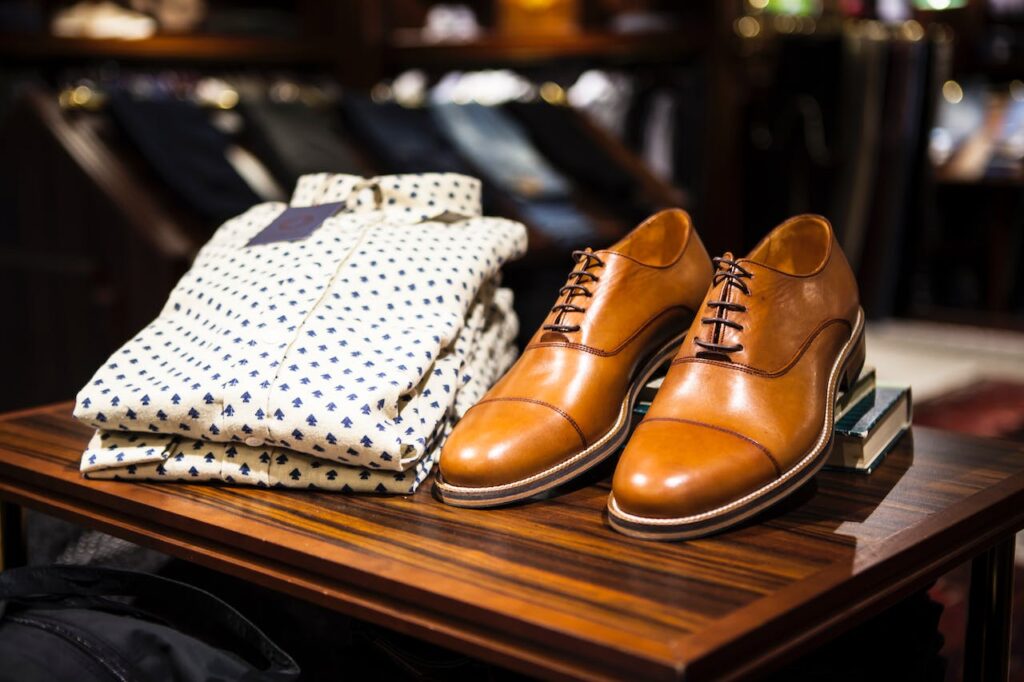
I still remember the day I stepped into my first formal event wearing a sharp black suit paired with… brown shoes. Yes, you read that right. Brown shoes with a black suit!
I thought I was making a bold fashion statement, but the only statement I made was “I have no idea how to coordinate colors.”
That’s when I realized the importance of color coordination in men’s fashion. It’s not just about looking good, it’s about feeling confident and making the right impression.
From that day forward, I embarked on a journey to master the art of matching men’s dress shoes with various outfits.
This guide is a culmination of that journey. Here, we’ll explore how to match shoes with pants, discuss suit and shoe combinations, and even touch on dress code shoe guidelines.
The Basics of Color Coordination
The Color Wheel and Fashion
The color wheel, our trusty guide in the world of color matching, isn’t just for artists. It’s a secret weapon in the fashion world too.
Understanding the color wheel can help you make sense of which colors complement each other and which ones clash like two alpha lions fighting for territory.
Primary, Secondary, and Tertiary Colors
Primary colors are like the parents of the color world. They’re the OGs – red, blue, and yellow.
Mix them together, and you get secondary colors – green, orange, and purple. Mix a primary color with a secondary color, and voila! You’ve got yourself a tertiary color.
Complementary Colors
Complementary colors are opposite each other on the color wheel. They’re like the Romeo and Juliet of colors – perfect for each other but not always the best idea to put together unless you really know what you’re doing.
Analogous Colors
Analogous colors are next to each other on the color wheel. They’re like best friends who always get along and look great together.
The 60-30-10 Rule
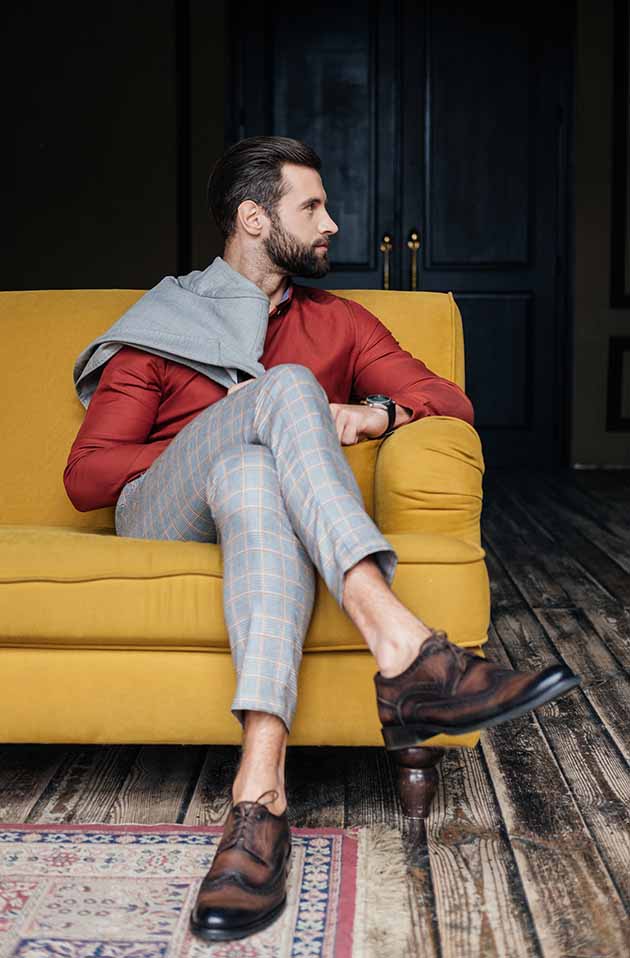
When it comes to outfit coordination, a good rule of thumb is the 60-30-10 rule.
Your dominant color takes up 60% of your outfit, your secondary color 30%, and your accent color 10%.
It’s like a pie chart for your outfit!
Now that we’ve covered the basics of color coordination, let’s move on to the fun part – applying these principles to men’s dress shoes!
Understanding Men’s Dress Shoes
A Walk Through Different Styles
Men’s dress shoes come in a variety of styles, each with its own charm and rules. Let’s take a stroll through the most popular ones:
Oxfords
Oxfords are the James Bond of dress shoes – classic, elegant, and always in style. They’re known for their closed lacing system and are perfect for formal occasions.
Derbies
Derbies are the laid-back cousin of Oxfords. They have an open lacing system which makes them more casual and versatile.
Loafers
Loafers are the free spirits of the shoe world. No laces, no problem! They’re easy to slip on and off, making them perfect for a smart-casual look.
The Color Palette of Men’s Dress Shoes
When it comes to Men’s Dress Shoes, there are a few classic colors to consider:
- Black: The most formal color. It’s like the little black dress of men’s shoes.
- Brown: Comes in various shades, each with its own vibe. It’s like the chameleon of shoe colors.
- Oxblood: A rich, dark red color that adds a pop of color to your outfit without being too loud.
Remember, the key to color coordination is not just about matching your shoes with your outfit, but also about creating a balanced look that reflects your personal style.
Matching Dress Shoes with Different Outfits
Formal Wear: Suit and Shoe Combinations
When it comes to formal wear, the rule of thumb is the darker the suit, the darker the shoe. Here are some classic suit and shoe combinations:
- Black Suit: Stick with black shoes. It’s like a classic Hollywood movie – black and white, simple and elegant.
- Navy Suit: Black, brown, or oxblood shoes work well. It’s like having a Swiss army knife in your wardrobe – versatile and practical.
- Grey Suit: Black or brown shoes are your best bet. It’s like salt and pepper – they just go together.
Business Attire Shoe Tips
In the business world, your shoes can say a lot about you. Here are some business attire shoe tips:
- Oxfords are a safe bet for most business settings. They’re like the reliable employee who always gets the job done.
- Brown shoes are generally more casual than black ones. They’re like the office jokester who knows when to be serious.
Casual Outfit Shoe Matching
Casual doesn’t mean sloppy. Here’s how to match your shoes with casual outfits:
- Jeans: Loafers, derbies, or even clean sneakers can work well. It’s like a casual Friday at the office – relaxed but still presentable.
- Chinos: Brown or oxblood shoes are a great choice. It’s like a weekend brunch – casual but classy.
Remember, the key to great style is not just about following rules but also about breaking them creatively. So feel free to experiment with different combinations and create your own unique style!
Shoe Color Guide
The Classic Colors
When it comes to Men’s Dress Shoes, there are a few classic colors that every man should have in his wardrobe:
- Black: The most formal color. Perfect for black-tie events or when you want to feel like James Bond.
- Brown: A versatile color that comes in various shades. It’s like the Swiss army knife of shoe colors.
- Oxblood: A rich, dark red color that adds a pop of color to your outfit without being too loud. It’s like the secret sauce that adds a little zing to your look.
Matching Shoe Color with Outfits
Matching your shoe color with your outfit is an art. Here are some general footwear color rules:
- Black shoes go well with black, grey, and navy outfits.
- Brown shoes can be paired with beige, blue, and brown outfits.
- Oxblood shoes work well with navy, black, and grey outfits.
Remember, these are just guidelines, not hard and fast rules. Feel free to experiment and create your own style!
Shoe Color for Every Occasion
Choosing the right shoe color can depend on the occasion. Here’s a quick shoe color guide:
- Formal events: Stick to black or oxblood shoes.
- Business meetings: Black or brown shoes are a safe bet.
- Casual outings: Feel free to experiment with different shades of brown or even colored leather shoes.
Remember, the key to great style is confidence. So wear your colors proudly!
Dress Code Shoe Guidelines
Understanding Dress Codes
Dress codes can be a minefield, but don’t worry, we’ve got you covered. Here’s a quick rundown of common dress codes and the Men’s Dress Shoes that go with them:
Black Tie
This is the most formal dress code, usually reserved for events like weddings or award ceremonies. Stick to black Oxfords – they’re like the tuxedo of shoes.
Business Formal
This is your typical 9-to-5 office dress code. Black or brown Oxfords or Derbies are a safe bet. They’re like the reliable colleague who always has your back during presentations.
Business Casual
This dress code gives you a bit more flexibility. Loafers or Derbies in any classic color (black, brown, oxblood) work well. They’re like the office cool guy who knows how to balance work and play.
Casual
This is where you can really let your personality shine through. Feel free to experiment with different shoe styles and colors.
Just remember, even though it’s casual, your shoes should still be clean and in good condition – they’re like your fun-loving friend who still knows when to be responsible.
The Golden Rule of Dress Codes
While it’s important to respect the dress code, it’s equally important to feel comfortable and confident in what you’re wearing. After all, the best accessory a man can wear is his confidence!
So there you have it – a comprehensive guide to navigating the world of dress codes and shoe colors. Remember, fashion should be fun, so don’t be afraid to experiment and create your own unique style!
Formal Wear: Suit and Shoe Combinations
When it comes to formal wear, the rule of thumb is the darker the suit, the darker the shoe. Here are some classic suit and shoe combinations:
Black Suit
Stick with black shoes. It’s like a classic Hollywood movie – black and white, simple and elegant.
Navy Suit
Black, brown, or oxblood shoes work well. It’s like having a Swiss army knife in your wardrobe – versatile and practical.
Grey Suit
Black or brown shoes are your best bet. It’s like salt and pepper – they just go together.
Remember, these are just guidelines. The real fun begins when you start breaking the rules creatively. So go ahead, give that navy suit and brown shoe combination a try! Who knows, you might just start a new trend.
Business Attire Shoe Tips
Navigating the world of business attire can sometimes feel like walking a tightrope. But don’t worry, I’ve got some tips to keep you balanced and stylish.
The Oxford Rule
In the business world, Oxfords are a safe bet for most settings. They’re like the reliable employee who always gets the job done.
Their closed lacing system gives them a sleek and formal look, making them perfect for those important meetings where you need to put your best foot forward.
The Color Code
When it comes to color, black or brown shoes are generally your go-to options.
Black is more formal and can be worn with virtually any color suit. Brown, on the other hand, is slightly more casual and offers more variety in terms of shades. It’s like the office jokester who knows when to be serious.
The Leather Standard
Regardless of the style or color, one thing remains constant – leather. Leather shoes are the gold standard in business attire. They’re durable, comfortable, and they have that professional sheen that says “I mean business”.
The Fit Factor
Last but not least, make sure your shoes fit well. A shoe that’s too tight or too loose can throw off your entire look (and make you walk funny).
Take the time to find the right fit – it’s like finding a good employee, it might take some time, but it’s worth it in the end.
In the world of business attire, your shoes are an extension of your personality. So choose wisely and strut confidently!
Casual Outfit Shoe Matching
The Art of Casual Coordination
Casual doesn’t mean careless. Even in a relaxed setting, the right shoe can elevate your outfit from “just grabbed whatever was clean” to “casually stylish”. Here’s how to match your shoes with casual outfits:
Jeans and Shoes: A Love Story
Jeans are the workhorse of casual wear. They’re like that friend who’s always there for you, no matter what. But just like with any friendship, the key is compatibility. Here are some shoe styles that go well with jeans:
- Loafers: For a smart-casual look, pair your jeans with loafers. It’s like adding a touch of class to your laid-back style.
- Derbies: Want to keep it cool and casual? Derbies are your best bet. They’re like the cool kid on the block who doesn’t try too hard but still stands out.
- Sneakers: For a relaxed and youthful look, you can’t go wrong with clean sneakers. They’re like the fun-loving friend who brings energy and comfort to your style.
Chinos: The Versatile Choice
Chinos are a step up from jeans but still on the casual side. They’re like the middle child who gets along with everyone. Here are some shoe styles that pair well with chinos:
- Brown Shoes: Brown shoes, especially in lighter shades, go well with chinos. It’s like a harmonious symphony where each element complements the other.
- Oxblood Shoes: For a more daring look, try oxblood shoes with your chinos. It’s like adding a dash of hot sauce to your favorite dish – it adds a kick without overpowering the flavor.
Remember, these are just guidelines. Feel free to mix and match based on your personal style and the occasion. After all, fashion is all about self-expression!
Shoe Color Guide
The Classic Colors
When it comes to dress shoes, there are a few classic colors that every man should have in his wardrobe:
- Black: The most formal color. Perfect for black-tie events or when you want to feel like James Bond.
- Brown: A versatile color that comes in various shades. It’s like the Swiss army knife of shoe colors.
- Oxblood: A rich, dark red color that adds a pop of color to your outfit without being too loud. It’s like the secret sauce that adds a little zing to your look.
Matching Shoe Color with Outfits
Matching your shoe color with your outfit is an art. Here are some general footwear color rules:
- Black shoes go well with black, grey, and navy outfits.
- Brown shoes can be paired with beige, blue, and brown outfits.
- Oxblood shoes work well with navy, black, and grey outfits.
These are just guidelines, not hard and fast rules. Feel free to experiment and create your own style!
Shoe Color for Every Occasion
Choosing the right shoe color can depend on the occasion. Here’s a quick shoe color guide:
- Formal events: Stick to black or oxblood shoes.
- Business meetings: Black or brown shoes are a safe bet.
- Casual outings: Feel free to experiment with different shades of brown or even colored leather shoes.
The key to great style is confidence. So wear your colors proudly!
Conclusion
While it’s important to understand the rules, fashion is all about self-expression. So don’t be afraid to experiment and create your own unique style.
So go ahead, put on those oxblood loafers with your navy suit, or those brown Derbies with your grey chinos. Who knows, you might just be the next trendsetter!
And in the world of fashion, your shoes are more than just a practical necessity – they’re the finishing touch that can make or break your outfit. So choose wisely, and strut confidently!

